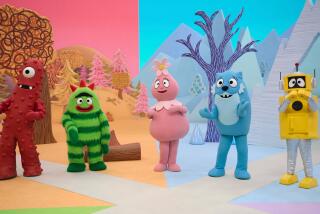Words Can Describe VH1’s ‘Pop-Up Video’ Series
- Share via
No Doubt’s huge hit, “Don’t Speak,” is playing for the zillionth time on VH1. As lead singer Gwen Stefani howls the lyrics, the viewer watches the interplay between band members. But this time, words appear on screen informing the viewer about the failed love affair between Stefani and bassist Tony Kanal.
“Tony and Gwen had no doubt about their love for eight years.” Then, a few seconds later:
“The night before this shoot the band fought and almost broke up.” Then:
“[Guitarist] Tom [Dumont] convinced the others a video about their ‘anger’ would be good therapy.”
This is “Pop-Up Video,” the hottest show on VH1, and it’s helped push the music video channel’s most recent ratings to their highest point ever among the station’s 58 million subscribers. It’s smart and smart-alecky. It combines pop culture arcana with music journalism, serving them up with the deflationary glee of a kid loudly pointing out an adult’s errant nose hair.
“Pop-Up Video” is a kind of Cliffs Notes for music videos that “pops up” boxes of text during songs. The text explains how the video was made, dishes sometimes-salacious details about performers and offers wry cultural commentary related to the performance. Each pop of a text box is accompanied by the sound of a bubble gurgling up.
Music videos have become more sophisticated since their birth, with ever-growing budgets and eye-popping special effects, but “Pop-Up Video” is a major innovation. More than a gimmick, it’s a droll critical examination of the art form. From an evolutionary viewpoint, it is a benchmark of TV viewers’ ability to process information. When MTV debuted in 1981, music videos were often criticized as incoherent because they sped along in a rush of rock music and rapid-fire imagery--sometimes producing sensory overload. On “Pop-Up Video,” viewers read the words on-screen, get the jokes and listen to the song. But unlike when MTV began, today, multimedia, multi-sensory communication is the status quo.
Most viscerally, “Pop-Up Video” is a memory ship, taking viewers of VH1 back to their college days when they and their friends stayed up all night watching MTV in its infancy. Part of the show’s success is no doubt due to its use of so many videos from the ‘80s.
Thanks to “Pop-Up Video,” VH1 viewers now know:
The role of Michael Jackson in the Jackson family’s 1984 video “Torture” was played by a wax dummy from Madame Tussaud’s in London, because the real Jackson didn’t show up for the filming.
The dreadlocks of Adam Duritz, frontman for Counting Crows, are hair extensions.
Activists claim 14 million animals a year are blinded by science, a factoid offered up during the video for Thomas Dolby’s “She Blinded Me With Science.”
“Pop-Up Video” is the brainchild of Tad Low and Woody Thompson, both 30. They met at summer camp in upstate New York when they were 10, but didn’t reunite until a few years ago. Low was a panelist on “Last Call,” a syndicated late-night talk show that ran from 1994-95, and brought Thompson on as a producer. After the show was canceled, Low and a friend--a wardrobe stylist for music videos--were drinking margaritas one night in Manhattan. As more drinks arrived, the friend started complaining about a particular music star’s tantrums while shooting a video. “Wow,” said Low, “that never showed up in the video.” Then he thought: Wouldn’t it be cool to get the scoop behind other videos? And then tell other people? On TV?
Low and Thompson pitched it to MTV and VH1, which caters to a slightly older audience (viewers over 25). VH1 bit first. The first shows aired in December. To Low and Thompson, it was crucial that the half-hour shows seem intelligent as well as irreverent. It wasn’t enough just to make wisecracks, like the robots of “Mystery Science Theatre 3000” or Beavis and Butt-head.
“That’s what separates us,” Thompson says. “Beavis and Butt-head might see an Alanis Morissette video and say, ‘She’s got a big butt.’ What we might do is pop a stat about Thighmaster sales.”
Low and Thompson realize that their idea might not have worked 10 or 15 years ago.
“We’re living in a multi-tasking world,” Low says. “We have screen-within-screen on TV and you can have more than one window open on your desktop computer.”
Most of the text boxes in “Pop-Up Video” have color icons attached, modeled after icons on computer screens. “The icon will instantly tell you what category you’re in and your brain can read the pop and get the joke,” Low says.
All in a matter of five to 10 seconds, which is how long each text box lingers on screen.
More to Read
The complete guide to home viewing
Get Screen Gab for everything about the TV shows and streaming movies everyone’s talking about.
You may occasionally receive promotional content from the Los Angeles Times.






